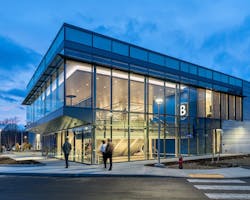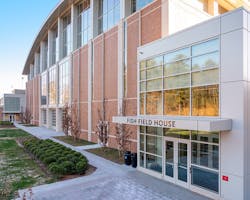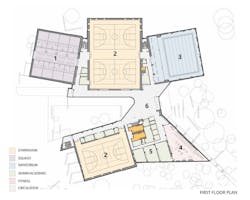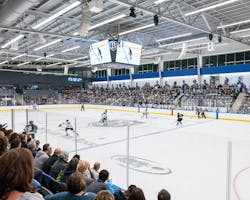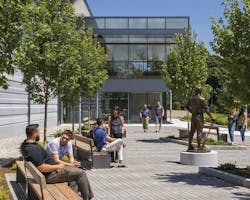Arenas on campuses aren’t just for sports anymore
By John Caulfield, Senior Editor
For the past several years, high schools and colleges have invested heavily in their on-campus sports complexes. And one of the trends that have emerging from that spending has been an increase in multipurpose arenas that can be used beyond the schedules of the school’s athletic teams.
One of the firm’s that have benefited from this trend is Architectural Resources Cambridge (ARC), which over the past few years has designed a number of these multipurpose centers in New England.
Those projects include the $52.6 million 115,700-sf Fish Field House on the Chestnut Hill, Mass., campus of Boston College. Fish Field, which opened a year ago, serves B.C.’s varsity football squad for indoor practice sessions, as well as the school’s recreational and club sports. Prior to the start of construction, this LEED Gold-certified building required flood mitigation; stormwater storage and management allowed Boston College to reclaim acreage on the edge of its campus.
The new Fish Field House at Boston College. Image: Courtesy of ARC
The Hackley School, a college prep institution in Tarrytown, N.Y., last year opened its new 115,000-sf Walter C. Johnson Center for Health and Wellness. Its sports-related spaces include three basketball courts, an eight-lane pool, eight squash courts, a wrestling room and indoor track. But the facility also has a wellness studio, three classrooms, a teaching kitchen, a student common area, café, and office space.
A schematic of The Hackley School's new Health and Wellness Center. Image: Courtesy of ARC
ARC designed a 76,000-sf multipurpose arena that opened in February 2018 on the Waltham, Mass., campus of Bentley University. While this building’s primary occupant is the school’s NCAA Division 1 Falcons ice hockey team, the arena has been designed to accommodate other events and activities, according to Nicole Chabot-Wieferich, Bentley’s Director of student programs and engagement.
“The impetus for this came from the students,” Chabot-Wieferich tells BD+C. “Hockey is a big draw on campus, but the students also wanted additional space to hold events and to build a community on campus.”
The facility, which has a seating capacity of 2,117 for hockey games and 3,400 for other events, has hosted concerts, career fairs, a Black United Body fashion show, admissions programs, and even the university’s President’s inauguration. In the first 15 months since its opening there have been more than 30,000 non-sports-related guests in the building.
Chabot-Wieferich says the arena is equipped with lighting packages and a sound system that are adjustable to different events. The technology also accommodates the hockey team with scoreboard replay and broadcasting capabilities.
The arena has classrooms, too, where, says Chabot-Wieferich, sustainability courses are taught. Students are using the arena as a living lab, analyzing the building’s energy data.
This is the first LEED-Platinum standalone ice arena in the country, and it boosts Bentley’s net-zero goals for 2030. (Thornton Tomasetti was the project’s LEED consultant.)
The other building team members on Bentley University's $45 million facility included Suffolk Construction (GC), Samiotes Consultants (engineer), McNamara-Salvia (SE), and Rist-Frost-Shumway Engineering (MEP).
